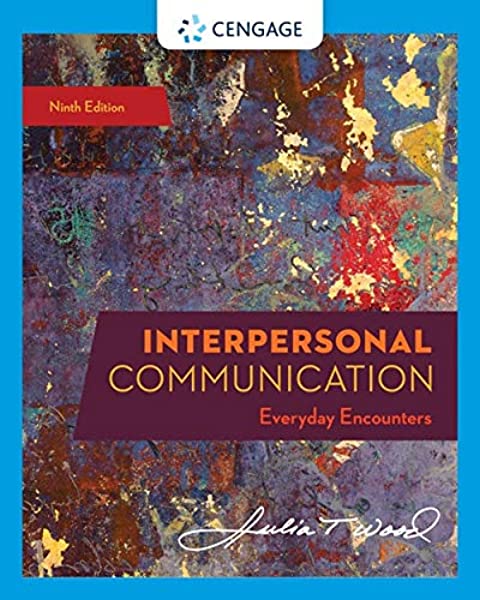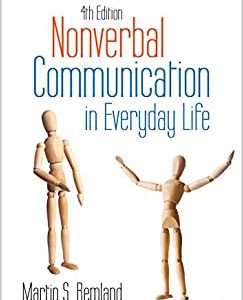(Ebook PDF) Interpersonal Communication Everyday Encounters 9th Edition by Wood 9798214346243 full chapters
$50.00 Original price was: $50.00.$25.00Current price is: $25.00.
Interpersonal Communication: Everyday Encounters 9th Edition by J.T. Wood – Ebook PDF Instant Download/DeliveryISBN: 9798214346243
Full download Interpersonal Communication: Everyday Encounters 9th Edition after payment.

Product details:
ISBN-13 : 9798214346243
Author: J.T. Wood
Written by leading scholar and award-winning teacher Julia T. Wood, INTERPERSONAL COMMUNICATION: EVERYDAY ENCOUNTERS, 9th Edition, relates theory and skills directly to students’ everyday interactions as it delivers a solid introduction to interpersonal communication. An emphasis on cultural diversity is thoroughly woven throughout the new 9th edition, equipping readers with the skills they need to effectively communicate with people who may not share a similar background. The new edition also features increased coverage of social media, including a section in every chapter that discusses connections between chapter themes and social media.
Interpersonal Communication: Everyday Encounters 9th Table of contents:
Chapter 1. A First Look at Interpersonal Communication
The Interpersonal Imperative
Physical Needs
Safety Needs
Belonging Needs
Self-Esteem Needs
Self-Actualization Needs
Participating Effectively in a Diverse Society
Defining Interpersonal Communication
A Communication Continuum
Features of Interpersonal Communication
Models of Interpersonal Communication
Linear Models
Interactive Models
Transactional Models
Principles of Interpersonal Communication
Principle 1: We Cannot Not Communicate
Principle 2: Interpersonal Communication Is Irreversible
Principle 3: Interpersonal Communication Involves Ethical Choices
Principle 4: People Construct Meanings in Interpersonal Communication
Principle 5: Metacommunication Affects Meanings
Principle 6: Interpersonal Communication Develops and Sustains Relationships
Principle 7: Interpersonal Communication Is Not a Panacea
Principle 8: Interpersonal Communication Effectiveness Can Be Learned
Social Media in Everyday Life
Guidelines for Interpersonal Communication Competence
Develop a Range of Skills
Adapt Communication Appropriately
Engage in Dual Perspective
Monitor Your Communication
Commit to Ethical Communication
Chapter Summary
Flashcards and Chapter Quiz
Application Activities
Chapter 2. Communication and Personal Identity
What Is the Self?
The Self Arises in Communication with Others
Particular Others
The Generalized Other
Presenting and Negotiating Identity
Social Media and Personal Identity
Guidelines for Enriching the Self
Make a Firm Commitment to Personal Growth
Gain and Use Knowledge to Support Personal Growth
Self-Disclose When Appropriate
Set Goals That Are Realistic and Fair
Seek Contexts That Support Personal Change
Chapter Summary
Flash Cards and Chapter Quiz
Application Activities
Chapter 3. Perception and Communication
The Process of Human Perception
Selection
Organization
Interpretation
Influences on Perception
Physiology
Expectations
Age
Culture
Cognitive Abilities
Self
Social Media and Perception
Guidelines for Improving Perception and Communication
Recognize That All Perceptions Are Partial and Subjective
Avoid Mind Reading
Check Perceptions with Others
Distinguish between Facts and Inferences
Guard against the Self-Serving Bias
Guard against the Fundamental Attribution Error
Monitor Labels
Chapter Summary
Flash Cards and Chapter Quiz
Application Activities
Chapter 4. The World of Words
The Symbolic Nature of Language
Symbols Are Arbitrary
Symbols Are Ambiguous
Symbols Are Abstract
Principles of Verbal Communication
Language and Culture Reflect Each Other
The Meanings of Language Are Subjective
Language Use Is Rule-Guided
Punctuation Shapes Meaning
Symbolic Abilities
Language Defines Phenomena
Language Evaluates
Language Organizes Perceptions
Language Allows Hypothetical Thought
Language Allows Self-Reflection
Speech Communities
Gendered Speech Communities
Social Media and Verbal Communication
Guidelines for Improving Verbal Communication
Engage in Dual Perspective
Own Your Feelings and Thoughts
Respect What Others Say about Their Feelings and Thoughts
Strive for Accuracy and Clarity
Chapter Summary
Flash Cards and Chapter Quiz
Application Activities
Chapter 5. The World beyond Words
Defining Nonverbal Communication
Similarities between Verbal and Nonverbal Communication
Differences between Verbal and Nonverbal Communication
Principles of Nonverbal Communication
Nonverbal Communication May Supplement or Replace Verbal Communication
Nonverbal Communication May Regulate Interaction
Nonverbal Communication Often Establishes Relationship-Level Meanings
Nonverbal Communication Reflects and Expresses Cultural Values
Types of Nonverbal Communication
Kinesics
Haptics
Physical Appearance
Artifacts
Environmental Factors
Proxemics and Personal Space
Chronemics
Paralanguage
Silence
Social Media and Nonverbal Communication
Guidelines for Improving Nonverbal Communication
Monitor Your Nonverbal Communication
Interpret Others’ Nonverbal Communication Tentatively
Chapter Summary
Flash Cards and Chapter Quiz
Application Activities
Chapter 6. Mindful Listening
The Listening Process
Mindfulness
Physically Receiving Messages
Selecting and Organizing Material
Interpreting Communication
Responding
Remembering
Obstacles to Mindful Listening
External Obstacles
Internal Obstacles
Forms of Nonlistening
Pseudolistening
Monopolizing
Selective Listening
Defensive Listening
Ambushing
Literal Listening
Adapting Listening to Communication Goals
Listening for Pleasure
Listening for Information
Listening to Support Others
Social Media and Listening
Guidelines for Effective Listening
Be Mindful
Adapt Listening Appropriately
Listen Actively
Chapter Summary
Flashcards and Chapter Quiz
Application Activities
Chapter 7. Emotions and Communication
Emotional Intelligence
Understanding Emotions
Physiological Influences on Emotions
Perceptual Influences on Emotions
Cultural Influences on Emotions
Obstacles to Communicating Emotions Effectively
Reasons We May Not Express Emotions
The Ineffective Expression of Emotions
Social Media and Emotions
Guidelines for Communicating Emotions Effectively
Identify Your Emotions
Choose Whether and How to Express Emotions
Own Your Feelings
Monitor Your Self-Talk
Adopt a Rational–Emotive Approach to Feelings
Respond Sensitively When Others Communicate Emotions
Chapter Summary
Flash Cards and Chapter Quiz
Application Activities
Chapter 8. Communication Climate: The Foundation of Personal Relationships
Features of Satisfying Relationships
Investment
Commitment
Trust
Comfort with Relational Dialectics
Confirming and Disconfirming Climates
Levels of Confirmation and Disconfirmation
Confirming and Disconfirming Communication
Social Media and Communication Climate
Guidelines for Creating and Sustaining Confirming Climates
Actively Use Communication to Build Confirming Climates
Accept and Confirm Others
Affirm and Assert Yourself
Respect Diversity in Relationships
Respond Constructively to Criticism
Chapter Summary
Flash Cards and Chapter Quiz
Application Activities
Chapter 9. Managing Conflict in Relationships
Defining Interpersonal Conflict
Expressed Tension
Interdependence
Perceived Incompatible Goals
The Felt Need for Resolution
Principles of Conflict
Principle 1: Conflict Is Natural in Most Western Relationships
Principle 2: Conflict May Be Expressed Overtly or Covertly
Principle 3: Social Groups Shape the Meaning of Conflict Behaviors
Principle 4: Conflict Can Be Managed Well or Poorly
Principle 5: Conflict Can Be Good for Individuals and Relationships
Orientations to Conflict
Lose–Lose
Win–Lose
Win–Win
Responses to Conflict
The Exit Response
The Neglect Response
The Loyalty Response
The Voice Response
Communication Patterns During Conflict
Unproductive Conflict Communication
Constructive Conflict Communication
Conflict Management Skills
Social Media and Conflict
Guidelines for Effective Communication During Conflict
Focus on the Overall Communication System
Time Conflict Purposefully
Aim for Win–Win Conflict
Honor Yourself, Your Partner, and the Relationship
Show Grace When Appropriate
Chapter Summary
Flash Cards and Chapter Quiz
Application Activities
Chapter 10. Friendships in Our Lives
The Nature of Friendship
Willingness to Invest
Emotional Closeness
Acceptance
Trust
Support
The Development of Friendship
Growth Stages
Deterioration Stages
Pressures on Friendships
Internal Tensions
External Pressures
Social Media and Friendships
Guidelines for Communication between Friends
Engage in Dual Perspective
Communicate Honestly
Grow from Differences
Don’t Sweat the Small Stuff
Chapter Summary
Flash Cards and Chapter Quiz
Application Activities
Chapter 11. Committed Romantic Relationships
Committed Romantic Relationships
Dimensions of Romantic Relationships
Styles of Loving
The Development of Romantic Relationships
People also search for Interpersonal Communication: Everyday Encounters 9th:
example of interpersonal communication
define interpersonal communication
interpersonal communication definition
importance of interpersonal communication
intrapersonal and interpersonal communication
Tags:
Interpersonal,Communication,Everyday Encounters,Wood
You may also like…
Politics & Philosophy - Anthropology
dictionaries & phrasebooks
Uncategorized
Uncategorized












